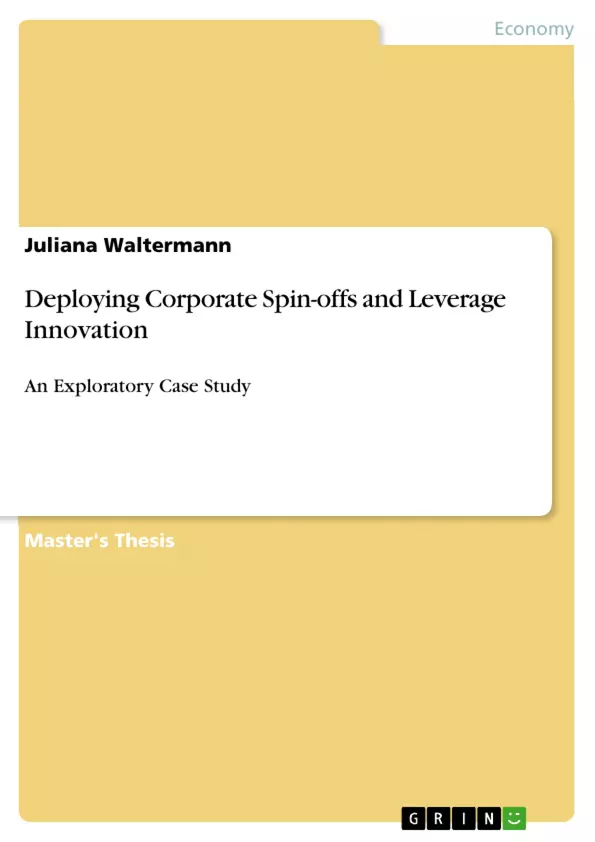The present work focuses on the relationship between corporate spin-offs and leverage innovation. Increasing global competition, fast technological improvement, and rising customer expectations put increasing pressure on companies to operate in an efficient and effective manner, while continuously developing new products and services to meet current market demand. This results in increasing pressure on research and development (R&D) activities, especially for science-driven industries such as the chemical, biotechnology, pharmaceutical, or semiconductor companies. Businesses operating in these industries have a two-sided relationship towards innovation: On the one hand, success is driven by their research outcome, resulting in large R&D investments. At the same time, however, the outputs of their research are highly uncertain and, therefore, bear significant risks towards the organization. Moreover, as companies mature in their market position, the need for innovation increases, while at the same time their ability to generate innovation.
One of the most effective means to foster corporate entrepreneurship and innovation is the creation of spin-offs, where a parent company separates parts of its business into a new entity. It is an agile attempt to innovation, the parent organization can improve innovativeness, flexibility, and efficiency without losing capacity and keeping focus on their core business activities. Thus, an organization has the chance to leverage R&D outcome without significantly increasing operational risk. On the other side, the Corporate Spin-off is provided with assets and investment support, which implicates a significant advantage compared to start-up companies that lack initial resources.
In this context, corporate spin-offs are described as one of the most effective means to foster innovativeness by combining the best of both worlds. However, current literature reveals a gap in providing best practices and drivers for success. In order to fill this gap, an exploratory case study on Henkel Adhesive Technologies and Afinitica will be performed to answer the question “How can companies in R&D intensive industries leverage their research outcome through corporate spin-offs?”. The study entails theoretical (i.e. conceptual framework) and managerial implications that contribute to research and praxis alike.
Inhaltsverzeichnis (Table of Contents)
- 1. Introduction
- 1.1. Problem Specification and Relevance of Topic
- 1.2. Problem Statement and Course of Investigation
- 2. Theoretical Foundation
- 2.1. The Innovation Dilemma and Organizational Ambidexterity
- 2.2. The Principle of Corporate Entrepreneurship
- 2.3. Open Innovation in the Context of Corporate Entrepreneurship
- 2.4. Corporate Spin-offs
- 2.1.1. Definition and Typology
- 2.1.2. Generic Shareholder Interests and Effects
- 2.1.3. Potential Risks and Challenges
- 3. Developing a Conceptual Framework
- 3.1. Overview
- 3.2. Organizational Context
- 3.2.1. Business Environment
- 3.2.2. Characteristics of the Parent Company
- 3.2.3. Characteristics of the Spin-off
- 3.3. Interrelationship
- 3.3.1. Pre-Separation Stage
- 3.3.2. Establishment Stage
- 3.3.3. Post- Separation Stage
- 4. Methodological Background
- 4.1. Research Design
- 4.1.1. Case Type and Selection
- 4.2. Data Collection
- 4.2.1. In-depth Interviews
- 4.2.2. Documents and Archival Records
- 4.3. Data Analysis
- 4.4. Quality of Research
- 5. The Case of Henkel and Afinitica
- 5.1. Overview
- 5.2. Dynamics within Science-Driven Industries
- 5.3. A Culture of Innovation
- 5.3.1. A Systematic Process to Innovation
- 5.3.2. Activities for Business Development
- 5.4. The unique Case Afinitica
- 5.4.1. Motivational Drivers
- 5.4.2. Business Model Strategy and Core Value
- 5.5. The Henkel-Afinitica Collaboration Ecosystem
- 5.5.1. Basic Construct
- 5.5.2. Capital Structure and Communication Process
- 5.5.3. Degree of Oversight and Control
- 5.6. Outcomes
- 5.6.1. Benefits for Afinitica
- 5.6.2. Benefits for Henkel
- 5.6.3. Challenges and Potential Barriers
- 6. Discussion
Zielsetzung und Themenschwerpunkte (Objectives and Key Themes)
This Master's thesis explores the potential of corporate spin-offs as a means to leverage innovation, specifically examining the case of Henkel Adhesive Technologies and its spin-off, Afinitica. The thesis aims to analyze the dynamics of corporate entrepreneurship and spin-off processes within the context of science-driven industries. It delves into the theoretical foundations of corporate entrepreneurship, organizational ambidexterity, and open innovation, examining how these principles contribute to the success of spin-offs.
- Corporate Entrepreneurship and Spin-offs
- Innovation Dilemmas and Organizational Ambidexterity
- Open Innovation in Corporate Entrepreneurship
- Case Study Analysis of Henkel and Afinitica
- Impact of Spin-offs on Innovation and Business Development
Zusammenfassung der Kapitel (Chapter Summaries)
Chapter 1 introduces the topic of corporate spin-offs and their potential for innovation, establishing the research problem and outlining the course of investigation. Chapter 2 delves into the theoretical foundation, exploring concepts such as organizational ambidexterity, corporate entrepreneurship, and open innovation. The chapter also discusses the nature, typology, and potential risks of corporate spin-offs. Chapter 3 develops a conceptual framework to guide the case study analysis, focusing on the organizational context of the parent company and the spin-off, as well as the interrelationship between them. Chapter 4 outlines the methodological background, including the research design, data collection methods, and data analysis approach. Chapter 5 presents the case study of Henkel and Afinitica, analyzing the dynamics within science-driven industries, the culture of innovation at Henkel, and the unique case of Afinitica. This chapter also explores the collaboration ecosystem between Henkel and Afinitica and examines the outcomes of the spin-off for both entities.
Schlüsselwörter (Keywords)
This thesis focuses on the key concepts of corporate entrepreneurship, corporate spin-offs, innovation, organizational ambidexterity, open innovation, and case study analysis. It examines these concepts through the lens of science-driven industries, with a specific focus on the case study of Henkel Adhesive Technologies and Afinitica. The research explores the potential of spin-offs as a means to leverage innovation and examines the benefits and challenges associated with this strategy.
- Citation du texte
- Juliana Waltermann (Auteur), 2018, Deploying Corporate Spin-offs and Leverage Innovation, Munich, GRIN Verlag, https://www.grin.com/document/448668



